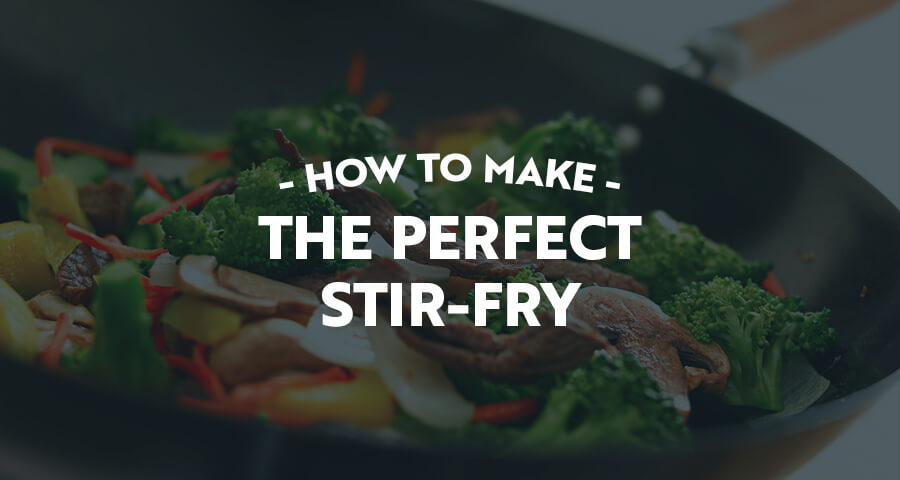When making the perfect stir-fry, one of the most important steps is to study Asian stir-fry history and the best tips and tricks to make a delicious dish. Stir-fry is a classic staple of Chinese cuisine, which has grown in popularity and is enjoyed worldwide. A stir-fry is an easy-to-make and delicious meal to enjoy that also provides numerous health benefits.
Stir-fry is exceptionally versatile, as you can add almost any protein or vegetable for a unique twist on this fan-favorite meal. You can make a vegetable stir-fry or replace meat in a recipe with tofu, seitan or other plant-based meat alternatives for a tasty meal. One of the most important steps to creating an authentic stir-fry is to cook this meal in a wok. Learn more about cooking stir-fry and standard stir-fry ingredients.
Table of Contents
What is Stir-Fry?
How to Make Stir-Fry
Tips to Improve Your Stir-Fry
Best Stir-Fry Variations
Gluten-Free and Non-GMO Soy Sauce and Sauces
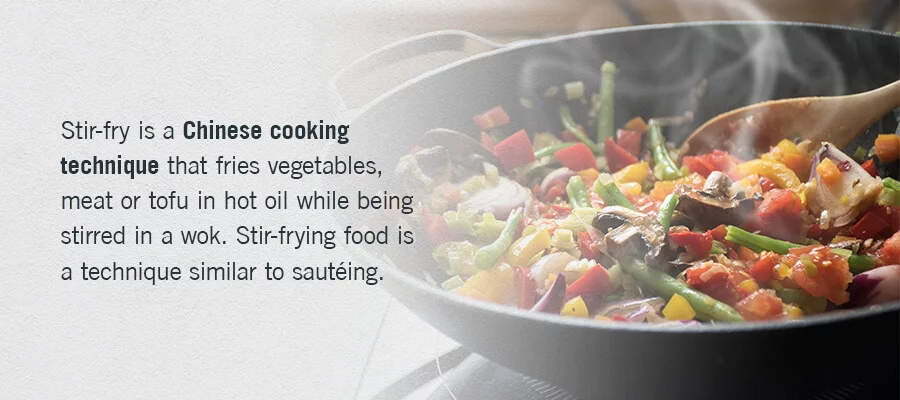
What Is Stir-Fry?
Stir-fry is a Chinese cooking technique that fries vegetables, meat or tofu in hot oil while being stirred in a wok. Stir-frying food is a technique similar to sautéing. Stir-fry is a versatile dish, allowing you to incorporate your favorite meats, meat alternatives and vegetables. The three main categories of standard stir-fry ingredients include proteins, vegetables and aromatics.
Proteins can be meat or plant-based, and some of the most popular include beef, chicken, pork, shrimp and salmon. Meatless protein options include tempeh, tofu and seitan. Common aromatics for stir-fry include ginger, green onions, garlic and shallots. You can use almost any vegetable in a stir-fry, including broccoli, snap peas, bell peppers, cauliflower, carrots and more.
In addition to being a delicious and easy-to-make meal, stir-fry is healthy and nutritious. A stir-fry often features nutritious vegetables and lean meats, providing your body with the nutrients it needs. Most people choose to serve stir-fry over white or brown rice, an excellent carbohydrate.
You can even swap out the oil you use for a healthier alternative, including grapeseed or avocado oil. Most foods in a stir-fry have a low-fat content and caloric value. Limiting the amount of oil you use when making a stir-fry can also reduce fat and calorie intake.
How to Make Stir-Fry
Stir-fry is a popular dish that is tasty, delicious and easy to make. A stir-fry is also a great way to incorporate a medley of vegetables into your meal. If this is one of your first times making a stir-fry, follow these simple directions for a tasty meal.
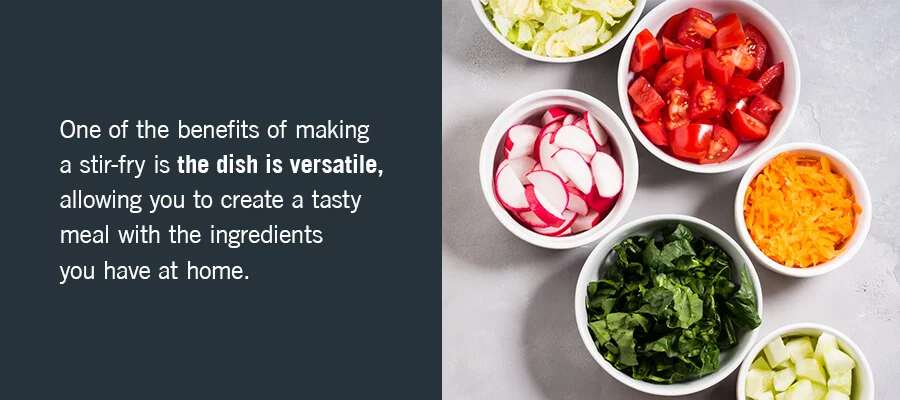
Select Your Ingredients
One of the first steps to making a stir-fry is ensuring you have all the ingredients you need. If you are following a special stir-fry recipe, you may want to stop at the store to pick up any ingredients you may need. One of the benefits of making a stir-fry is the dish is versatile, allowing you to create a tasty meal with the ingredients you have at home.
If possible, a stir-fry is always more delicious with fresh vegetables and ingredients. While you can use frozen or canned vegetables, fresh ingredients tend to provide a better taste to your meal. Once you are ready to cook your stir-fry, place all the ingredients on your counter and begin prepping.
Slice the Protein
When preparing your protein, slice or cut your meat or tofu into small pieces. The thinner your protein, the more quickly it will cook. If you add pork shoulder, steak or chicken thighs to your stir-fry, you should cut thinly against the grain. Scallops and shrimp are also delicious proteins for a stir-fry. While cutting your protein is an important step, you can keep smaller proteins, such as shrimp and scallops, whole because they are much more delicate than other protein types.
You should use extra-firm tofu if you plan to use tofu because softer tofu may be too delicate to stir-fry effectively. When preparing and cutting any protein for your stir-fry, the goal is to create small or thin pieces to achieve a tasty sear and flavor.
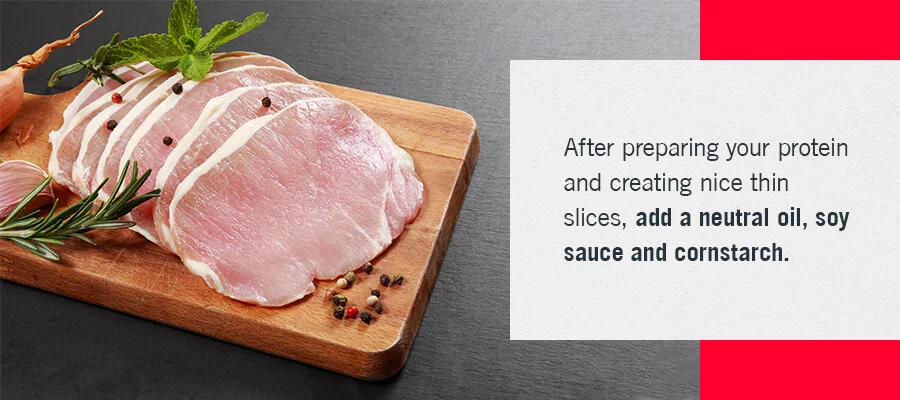
Coat Your Protein
After preparing your protein and creating nice thin slices, add a neutral oil, soy sauce and cornstarch. While coating your proteins in this mix, the soy helps to season the proteins, while the cornstarch helps the protein to brown more quickly and is essential for thickening the sauce later on. Finally, a neutral oil helps to keep the meats evenly coated and prevents sticking on your wok or pan.
Prepare Vegetables
After preparing your protein, you can start prepping your vegetables, which are a delicious addition to your dish’s nutrition, flavor and overall presentation. Because the meat is cut thin, choose vegetables that do not need a long time to get tender. Like your protein, slice and cut your vegetables into small or thinner pieces, maximizing surface area.
While you can add almost any vegetable to your stir-fry, some of the most popular vegetables include snap peas, asparagus and string beans. You can also choose bok choy and other greens as a delicious addition to your stir-fry. If you add denser vegetables, like carrots or cauliflower, cut them even smaller or cook them beforehand. Aromatics like scallion, ginger and garlic add a great base flavor to your vegetables.
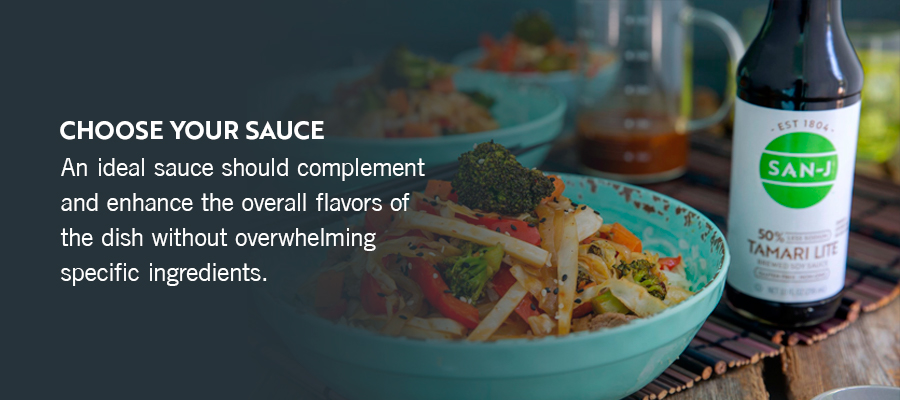
Choose Your Sauce
A delicious stir-fry is not complete without the perfect sauce that provides delicious flavors and ties the dish together. An ideal sauce should complement and enhance the overall flavors of the dish without overwhelming specific ingredients.
In addition to soy sauce, some popular stir-fry sauces include Teriyaki Sauce, Asian BBQ Sauce, Mongolian sauce or Korean BBQ Sauce. You may also enjoy Umami Tamari Splash, Sweet Tamari Splash and Citrus Tamari Splash. No matter the sauce you choose, it is sure to add a delicious flavor to your stir-fry.
Stir-fry is one of the dishes that are easier to make it gluten free. Make sure to choose certified gluten-free sauces to make a gluten-free stir fry as there may be hidden gluten ingredients in sauces.
Cook the Vegetables
Preheat your oil over medium-high heat in your wok or pan. Once your wok or pan is preheated, add your vegetables and aromatics and cook them for about three to five minutes, depending on the vegetable. Stir and shake the pan often to get an even sear on your vegetables and prevent burning one side.
Stir-Fry Your Protein
After you have cooked and set your vegetables aside, cook your proteins. If you are cooking meat, lay the slices down on a single layer to brown nicely for two to three minutes. You will want to get a nice sear and color on each side of meat, being careful not to overcook it. Turn or stir your meat to cook and brown the other side.
Once the fat renders and juices begin to pool at the bottom of the wok or pan, give your protein another stir and add your cooked vegetables back into the pan to combine the flavors. If you are cooking a plant-based meat alternative, like tofu, provide a nice golden sear before adding the vegetables back to your stir-fry.
Add Your Sauce
Now, it is time for the star of your dish to shine — your sauce! After selecting the perfect sauce for your stir-fry, add it to your protein and vegetables. When adding your sauce, you should make sure all of your ingredients are evenly coated and the sauce has thickened slightly. Thicken your sauce if needed with a cornstarch slurry. A cornstarch slurry can be made by mixing cornstarch with the same amount of water.
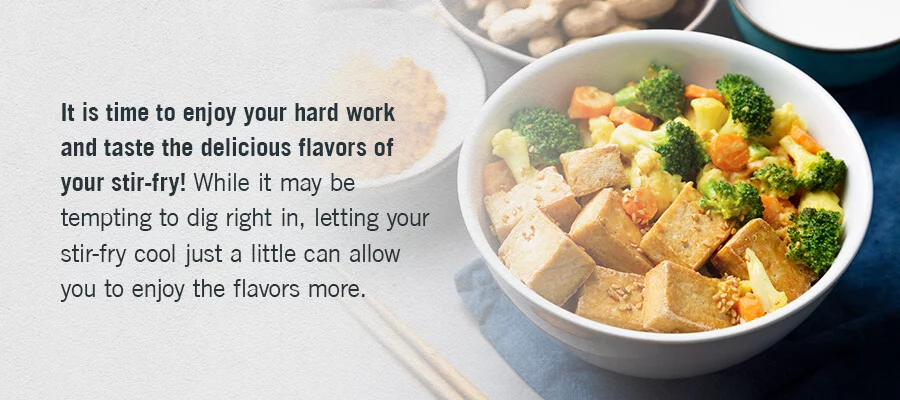
Plate and Enjoy
It is time to enjoy your hard work and taste the delicious flavors of your stir-fry! You can serve your stir-fry over white rice, brown rice, Japanese rice, quinoa or even glass noodles. Adding a simple garnish like chopped scallions can elevate your dish’s overall appearance and presentation. Dig in and enjoy your tasty stir-fry!

Tips to Improve Your Stir-Fry
If you have mastered the basics of making a traditional stir-fry, consider tips and tricks to elevate your cooking to the next level. These six stir-fry tips and tricks can help you improve your stir-fry cooking techniques and enhance your meal’s flavors:
1. Choose High-Quality Ingredients
Choosing the right ingredients is essential to making a delicious, easy stir-fry. If your recipe calls for soy sauce, choose a high-quality, flavorful soy sauce for the most delicious meal. A high-quality soy sauce should have bold flavor and superior flavor-enhancing properties. Additionally, a soy sauce that is made of 100% soy and no wheat can have a richer and more complex flavor.
In addition to traditional soy sauce, you can choose a less-sodium soy sauce if you are conscious of your sodium intake. There are also organic, gluten-free soy sauce options available. In addition to your sauce, it is typically best to use fresh vegetables and meats for a truly delicious meal. If you use a meat alternative, such as tofu, you should use extra firm tofu when making a stir-fry.
2. Prepare Your Ingredients
One of the most important steps to making a delicious stir-fry is preparing your ingredients beforehand. While a stir-fry may be simple in terms of ingredients and steps, it happens fast. If you do not have all ingredients prepared and chopped before cooking, you may become overwhelmed and risk missing a step or undercooking a vegetable.
It is helpful to have all ingredients chopped and sliced before you start cooking. Any dry or wet ingredients should be measured out and set aside for when you need them. You will have to be ready to add ingredients quickly, so having them measured and set aside is extremely helpful. Once your pan is heated, you do not need to leave your spot, meaning all ingredients should be prepared and easily within reach.
3. Slice and Chop Ingredients
Slicing and chopping your vegetables and meats is essential to preparing your ingredients before cooking your stir-fry. When slicing and chopping your ingredients, the main goal is to create as much surface area as possible to provide a nice sear. When cutting your vegetables, you can slice them thinly or on a diagonal to increase surface area.
On the other hand, you should finely chop aromatics like ginger or garlic. Meats and proteins should be sliced against the grain to increase tenderness and flavor.
4. Use a Wok or Cast-Iron Pan
If you have a wok, you should always use this when making a stir-fry. Because a wok retains heat well and has a larger surface area, it is ideal for cooking the perfect stir-fry. A cast-iron pan is a great alternative if you do not have a wok. It is important to remember that you want the pan to remain hot and sizzling even when adding additional ingredients. Woks and cast-iron pans retain heat better than other pan types.
5. Preheat Your Pan
Preheating your pan or wok is an important step. You do not want to be ready to cook and add your ingredients to a cold pan. A higher pan temperature helps achieve a nice sear on the vegetables and proteins of your dish while imparting flavor to the ingredients.
Your pan should give off a nice sizzle and remain sizzling from the start of your cooking to when you take your pan or wok off the heat. To determine if your pan is hot enough, add a drop or two of water to your pan. If the water drop evaporates in a second or two, it is properly preheated. While preheating is effective, you do not want to burn your ingredients, so keep an eye on your heat.
6. Use High Smoke Point Oils
While you may be tempted to grab your bottle of olive oil for a stir-fry, this may not be the best oil for stir-fry. Instead, use a high smoke point oil. Because a stir-fry is cooked on high heat, a lower smoke point oil, such as olive oil, may be easier to burn, creating an unpleasant taste. Use grapeseed, canola, peanut, ghee or avocado oil.
Best Stir-Fry Variations
While traditional stir-fry is a delicious dish to enjoy, there are numerous flavors and ingredients you can choose from for a refreshing take on one of your favorite meals. If you are looking for a healthy stir-fry with soy sauce, orange sauce or other unique flavors, consider some of these stir-fry recipes:
Spicy Beef and Vegetable Stir-Fry
If you are a fan of traditional stir-fry but like a bit of spice and an extra kick in your meals, you may enjoy spicy beef and vegetable stir-fry! This deliciously bold recipe can be adjusted to fit your preferred spice level. You can also use fewer chili flakes for a milder stir-fry, or you can kick up the heat with a little extra spice if you prefer.
Spicy beef and vegetable stir-fry is flavored with red chili flakes, fresh ginger and Chinese five spice for a unique and zesty flavor. Chili garlic paste is also one of the main ingredients, largely responsible for the overall spiciness of your dish. This Tamari Lite stir-fry sauce recipe also calls for brown sugar for a little sweetness to balance the overall spice of the dish with half the sodium than regular Tamari.
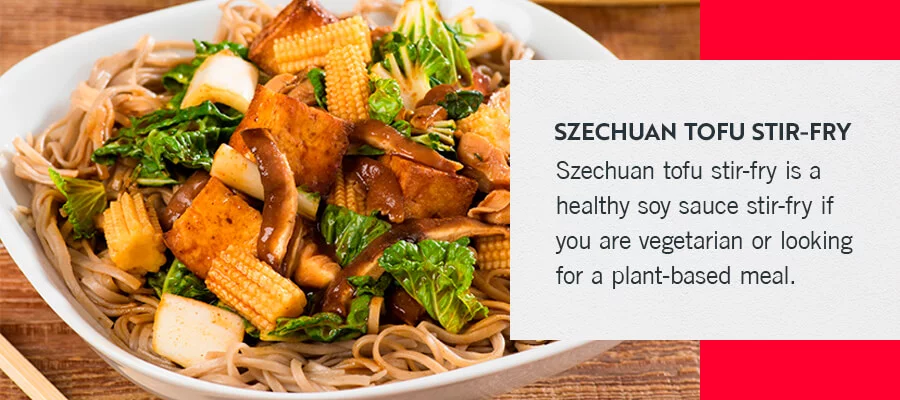
Szechuan Tofu Stir-Fry
Szechuan tofu stir-fry is a healthy soy sauce stir-fry if you are vegetarian or looking for a plant-based meal. This dish is deliciously flavored with gluten-free Szechuan Sauce, letting you raise the heat with a tasty, tongue-tingling flavor. Szechuan sauce features notes of ginger, sesame, plum and a blend of spices along with Tamari Soy Sauce for a umami-rich flavor profile.
This dish is full of unique flavors, with shiitake mushrooms, bok choy, grapeseed oil and baby corn cobs. Of course, this delicious stir-fry would not be complete without golden brown tofu to complement the tasty vegetables. Add as much or as little Szechuan sauce to your stir-fry to achieve the perfect level of zing.
Sweet and Tangy Shrimp Stir-Fry
A sweet and tangy shrimp stir-fry is a great way to switch up your dinner, especially if you prefer sweet flavors rather than spicy. This stir-fry gets its tasty flavor from the gluten-free Sweet & Tangy Sauce. SAN-J’s Sweet & Tangy Sauce is inspired by Polynesian cuisine, making it a unique and exciting addition to any meal. This sauce is made of various spices, a blend of fruit juices and honey for the perfect smooth glaze.
The rich flavor of sweet and tangy sauce makes it the perfect addition to a tofu or shrimp-based dish. Along with sweet and tangy marinated shrimp, this stir-fry calls for slices of zucchini, red bell pepper and sweet corn for a delicious medley of vegetables. You can serve this shrimp stir-fry with a side of white rice, brown rice or even quinoa for a twist.
Hoisin Pork Stir-Fry
Hoisin pork stir-fry gets its unique flavor from gluten-free Hoisin Sauce, an excellent substitute for soy sauce in a stir-fry. Hoisin sauce is an ideal blend of sweet, savory and salty flavors and is a traditional Chinese condiment, ideal for an Asian stir-fry recipe. Hoisin sauce is made of ginger puree, brown sugar, garlic and a delicious blend of seasonings for a refreshing flavor.
Hoisin sauce pairs perfectly with pork tenderloin for this stir-fry dish. This stir-fry also calls for sliced onions, trimmed snow peas and sliced bamboo shoots and serves perfectly over white rice.
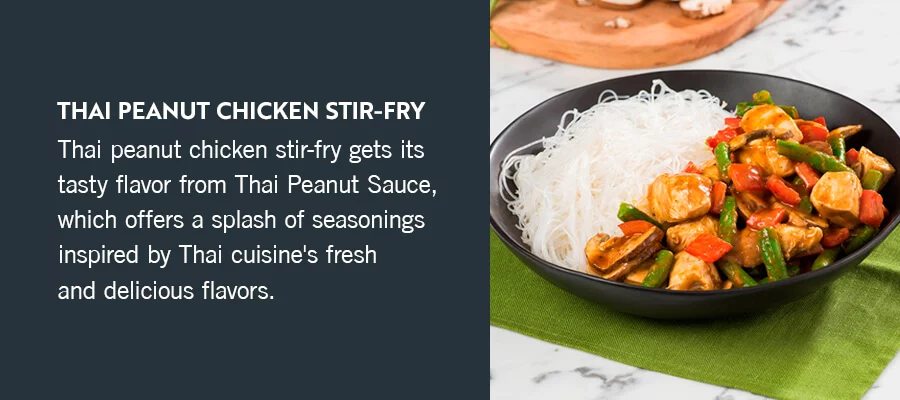
Thai Peanut Chicken Stir-Fry
Thai peanut chicken stir-fry gets its tasty flavor from Thai Peanut Sauce, which offers a splash of seasonings inspired by Thai cuisine’s rich and delicious flavors. Thai peanut sauce provides a sweet, spicy and nutty flavor for a mouthwatering stir-fry. While Thai peanut sauce features complex flavors, pairing this sauce with food is easy.
Thai peanut sauce is exceptionally versatile and complements pork, chicken, tofu and more. The flavors of Thai peanut sauce perfectly pull together the ingredients for this dish, including green beans, brown mushrooms and red bell peppers. After preparing your Thai peanut chicken stir-fry, serve it over delicious rice noodles.
Orange Salmon Stir-Fry
If you are a salmon lover, you may want to try orange salmon stir-fry for a unique meal. One of the main ingredients of this dish is Asian Orange Sauce, which introduces citrusy sweet flavors to any meal. Orange sauce features delicious spices and seasonings and a hint of Tamari Soy Sauce and is certified gluten-free.
Orange salmon stir-fry calls for salmon fillet along with fresh asparagus, water chestnuts and green onions for a refreshingly delicious taste. While you can serve orange salmon stir-fry over white or brown rice, it can be exceptionally delicious served over glass noodles.

Gluten-Free and Non-GMO Soy Sauce and Sauces
At SAN-J, we are dedicated to making and distributing high-quality soy sauce and other Asian sauces. The Sato family first began making miso and soy sauce in 1804. Eight generations later, we continue to brew the highest quality sauces from the finest soybeans for exceptional and unrivaled flavor.
Our Tamari Soy Sauce contains no wheat and is made of 100% soybeans for the best flavor possible, meaning our finished products contain more soy protein and complex flavors. Our brewing methods create authentic soy sauce and ingredients to be the perfect addition to your kitchen.
Browse our products online today or contact us online to find the perfect bottle of soy sauce for your next stir-fry or meal.
Back to Top

